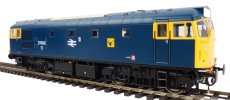A bit of a wide ranging subject eh?
I was prompted to start this when I noticed something on this Heljan 0 gauge class 27 that’s just about to be released:

The loco has a Highland Rail motif on the side, but I don’t recall them ever having them? I know 26s did obviously but were any 27s allocated to Inverness before they were withdrawn?
Aside from that I’ve got a few questions about some of the branch line workings out to Kyle and Mallaig etc.
Post the introduction of Radio Electronic Token Block (RETB) signalling, which classes of loco were able to work where? Out to the West Highlands (Glasgow - Fort William/Oban/Mallaig) was it just a handful of class 20s and the Eastfield 37/4s?
Then with the Inverness to Thurso and Wick or Kyle line’s, was it the IS (Inverness) 37/4s and later a couple of IS depot pet 26s in the early 1990s? Or were there other 26s fitted with RETB back then?
It’s an area and era that I’ve always found fascinating I must say.
I was prompted to start this when I noticed something on this Heljan 0 gauge class 27 that’s just about to be released:

The loco has a Highland Rail motif on the side, but I don’t recall them ever having them? I know 26s did obviously but were any 27s allocated to Inverness before they were withdrawn?
Aside from that I’ve got a few questions about some of the branch line workings out to Kyle and Mallaig etc.
Post the introduction of Radio Electronic Token Block (RETB) signalling, which classes of loco were able to work where? Out to the West Highlands (Glasgow - Fort William/Oban/Mallaig) was it just a handful of class 20s and the Eastfield 37/4s?
Then with the Inverness to Thurso and Wick or Kyle line’s, was it the IS (Inverness) 37/4s and later a couple of IS depot pet 26s in the early 1990s? Or were there other 26s fitted with RETB back then?
It’s an area and era that I’ve always found fascinating I must say.





